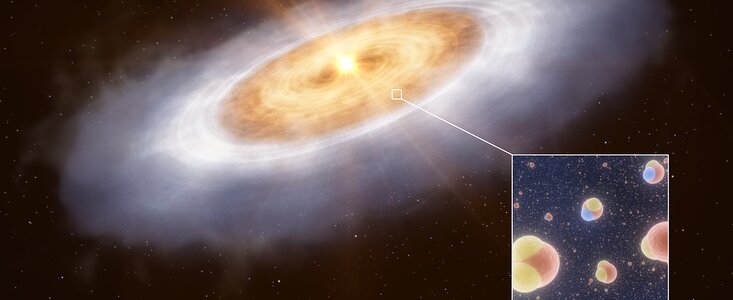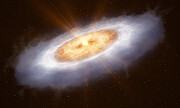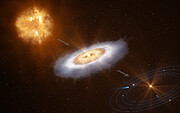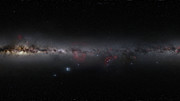Persbericht
Astronomen vinden ontbrekende schakel voor water in het zonnestelsel
8 maart 2023
Met behulp van de Atacama Large Millimeter/submillimeter Array (ALMA) hebben astronomen gasvormig water ontdekt in de planeet-vormende schijf rond de ster V883 Orionis. De chemische signatuur van dit water verklaart hoe water uit sterren-vormende gaswolken planeten kan bereiken. De ontdekking ondersteunt het idee dat het water op aarde nog ouder is dan onze zon.
‘We kunnen de oorsprong van het water in ons zonnestelsel nu herleiden tot vóór de vorming van de zon’, zegt John J. Tobin, astronoom aan het National Radio Astronomy Observatory in de VS en hoofdauteur van de vandaag in Nature gepubliceerde studie.
De ontdekking werd gedaan door de samenstelling van water te onderzoeken in V883 Orionis, een planeet-vormende schijf op ongeveer 1300 lichtjaar van de aarde. Wanneer een wolk van gas en stof ineenstort, vormt zich een ster in het centrum, met daaromheen een schijf van restmaterie. Dit materiaal klontert in de loop van enkele miljoenen jaren samen tot kometen, planetoïden en uiteindelijk planeten. Tobin en zijn team gebruikten ALMA, waarin de Europese Zuidelijke Sterrenwacht (ESO) partner is, om de chemische kenmerken van het water en diens weg van de stervormingswolk naar de planeten te meten.
Water bestaat gewoonlijk uit één zuurstofatoom en twee waterstofatomen. Tobins team onderzocht een iets zwaardere versie van water waarbij één van de waterstofatomen is vervangen door deuterium – een zware isotoop van waterstof. Omdat normaal en zwaar water onder verschillende omstandigheden ontstaan, kan hun verhouding worden gebruikt om na te gaan wanneer en waar het water is gevormd. Zo is bijvoorbeeld aangetoond dat deze verhouding in sommige kometen van ons zonnestelsel vergelijkbaar is met die in aards water. Dat wijst erop dat kometen water naar onze planeet kunnen hebben gebracht.
De reis van water van wolken naar jonge sterren, en vervolgens van kometen naar planeten is al eerder waargenomen, maar tot nu toe ontbrak de link tussen de jonge sterren en de kometen. ‘V883 Orionis is in dit geval de ontbrekende schakel’, zegt Tobin. ‘De samenstelling van het water in de schijf lijkt sterk op die van kometen in ons eigen zonnestelsel. Dit is een bevestiging van het idee dat het water in planetenstelsels miljarden jaren geleden, dus vóór de zon, in de interstellaire ruimte is gevormd en relatief onveranderd door zowel kometen als de aarde is geërfd.’
Maar het waarnemen van het water bleek niet eenvoudig. ‘Het meeste water in planeet-vormende schijven is bevroren tot ijs, zodat het doorgaans aan ons zicht wordt onttrokken’, zegt medeauteur Margot Leemker, promovendus aan de Sterrewacht Leiden. Gasvormig water kan worden gedetecteerd dankzij de straling die moleculen uitzenden wanneer zij ronddraaien en trillen. Maar als water bevroren is, bewegen de moleculen veel minder. Gasvormig water is te vinden in het midden van de schijf rond de ster, waar het warmer is. Deze gebieden gaan echter schuil achter de schijf zelf en zijn bovendien te klein om waarneembaar te zijn met onze telescopen.
Gelukkig is uit recent onderzoek gebleken dat de schijf van V883 Orionis ongewoon warm is: door een krachtige uitbarsting van energie van de ster is hij verwarmd ‘tot een temperatuur waarbij water niet langer ijsvormig is, maar gasvormig, waardoor we het kunnen detecteren’, aldus Tobin.
Het team heeft ALMA, een grote opstelling van radiotelescopen in het noorden van Chili, gebruikt om het gasvormige water in V883 Orionis waar te nemen. Dankzij de grote gevoeligheid en de hoge resolutie van dit instrument konden de astronomen het water niet alleen detecteren, maar ook de samenstelling ervan bepalen en de verdeling ervan binnen de schijf in kaart brengen. Daarbij is vastgesteld dat de schijf minstens 1200 keer zoveel water bevat als alle oceanen op aarde bij elkaar.
In de toekomst hopen de astronomen gebruik te kunnen maken van ESO’s in aanbouw zijnde Extremely Large Telescope en diens eerste-generatie-instrument METIS. Dit middel-infraroodinstrument zal gasvormig water in dit soort schijven kunnen onderscheiden, en daarmee het verband tussen de weg die het water aflegt van sterren-vormende wolken naar planetenstelsels versterken. ‘Dit zal ons een veel completer beeld geven van het ijs en gas in planeet-vormende schijven,’ besluit Leemker.
Meer informatie
De resultaten van dit onderzoek zijn te vinden in het artikel ‘Deuterium-enriched water ties planet-forming disks to comets and protostars’ dat in Nature verschijnt (doi: 10.1038/s41586-022-05676-z).
Het onderzoeksteam bestaat uit John J. Tobin (National Radio Astronomy Observatory, VS), Merel L.R. van’t Hoff (Department of Astronomy, University of Michigan, VS), Margot Leemker (Sterrewacht Leiden [Leiden]), Ewine F. van Dishoeck (Leiden), Teresa Paneque-Carreño (Leiden; European Southern Observatory, Duitsland), Kenji Furuya (National Astronomical Observatory of Japan, Japan), Daniel Harsono (Institute of Astronomy, National Tsing Hua University, Taiwan), Magnus V. Persson (Department of Space, Earth and Environment, Chalmers University of Technology, Onsala Space Observatory, Zweden), L. Ilsedore Cleeves (Department of Astronomy, University of Virginia, VS), Patrick D. Sheehan (Center for Interdisciplinary Exploration and Research in Astronomy, Northwestern University, VS) en Lucas Cieza (Núcleo de Astronomía, Facultad de Ingeniería, Millennium Nucleus on Young Exoplanets and their Moons, Universidad Diego Portales, Chili).
De Europese Zuidelijke Sterrenwacht (ESO) stelt wetenschappers van over de hele wereld in staat om de geheimen van het heelal te ontdekken, ten bate van iedereen. Wij ontwerpen, bouwen en exploiteren observatoria van wereldklasse die door astronomen worden gebruikt om spannende vragen te beantwoorden en de fascinatie voor astronomie te verspreiden, en bevorderen internationale samenwerking op het gebied van de astronomie. ESO, in 1962 opgericht als intergouvernementele organisatie, wordt inmiddels gedragen door 16 lidstaten (België, Denemarken, Duitsland, Finland, Frankrijk, Ierland, Italië, Nederland, Oostenrijk, Polen, Portugal, Spanje, Tsjechië, het Verenigd Koninkrijk, Zweden en Zwitserland) en door het gastland Chili, met Australië als strategische partner. Het hoofdkwartier van de ESO en haar bezoekerscentrum en planetarium, de ESO Supernova, zijn gevestigd nabij München in Duitsland, maar onze telescopen staan opgesteld in de Chileense Atacama-woestijn – een prachtige plek met unieke omstandigheden voor het doen van hemelwaarnemingen. ESO exploiteert drie waarnemingslocaties: La Silla, Paranal en Chajnantor. Op Paranal staan ESO’s Very Large Telescope en Very Large Telescope Interferometer, evenals surveytelescopen zoals VISTA. Ook zal ESO op Paranal de Cherenkov Telescope Array South huisvesten en exploiteren – ’s werelds grootste en gevoeligste observatorium van gammastraling. Samen met internationale partners beheert ESO APEX en ALMA op Chajnantor, twee faciliteiten die de hemel waarnemen in het millimeter- en submillimetergebied. Op Cerro Armazones, nabij Paranal, bouwen wij ‘het grootste oog ter wereld’ – ESO’s Extremely Large Telescope. Vanuit onze kantoren in Santiago, Chili, ondersteunen wij onze activiteiten in het gastland en werken wij samen met Chileense partners en de Chileense samenleving.
Links
- Onderzoeksartikel
- Foto's van ALMA
- Voor journalisten: abonneer je op persberichten in je eigen taal
- Voor wetenschappers: heb je een verhaal? Promoot je onderzoek!
Contact
John J. Tobin
National Radio Astronomy Observatory
Charlottesville, USA
E-mail: jtobin@nrao.edu
Margot Leemker
Leiden Observatory
Leiden, the Netherlands
E-mail: leemker@strw.leidenuniv.nl
Juan Carlos Muñoz Mateos
ESO Media Officer
Garching bei München, Germany
Tel: +49 89 3200 6176
E-mail: press@eso.org
Marieke Baan (press contact Nederland)
ESO Science Outreach Network
and NOVA Informatie Centrum
Tel: +31(0)20-5257480
Email: eson-netherlands@eso.org
Over dit bericht
| Persberichten nr.: | eso2302nl |
| Naam: | V883 Orionis |
| Type: | Milky Way : Star : Circumstellar Material : Disk |
| Facility: | Atacama Large Millimeter/submillimeter Array |







